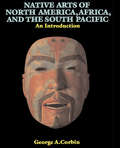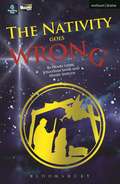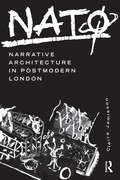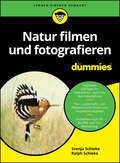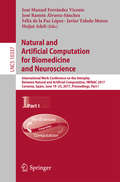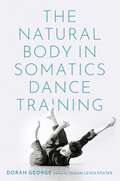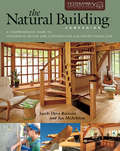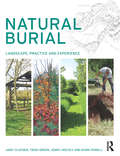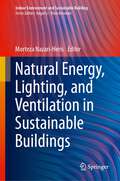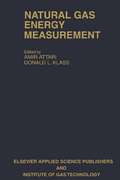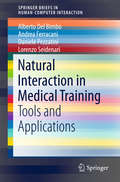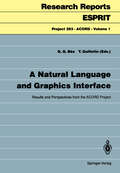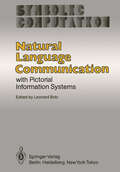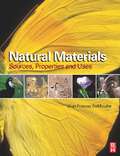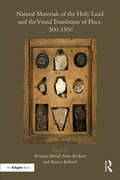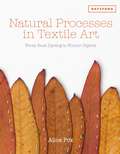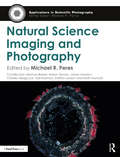- Table View
- List View
Native Arts Of North America, Africa, And The South Pacific: An Introduction
by George A. CorbinThis introduction to the art of tribal peoples of North America, Africa, and the South Pacific does not briefly cover the hundreds of artistic traditions in these three vast areas but rather studies in depth thirty-six art styles within all three areas using the methods of art history, including stylistic analysis and iconographic interpretation. Emphasis is on the art in cultural context and as a system of visual communication within each tribal area. Where appropriate for a more complete understanding of the art, data from archaeology, ethnology, linguistics, religion, and other humanistic disciplines are included.Among the peoples and cultures whose art is studied are the Haida, Kwakiutl, and Tlingit; the Hohokam and Mongollon, the Anasazi and Hopi; the Dogon and Bamana of Mali; the Asante of Ghana; the Benin, Yoruba, and Ibo of Nigeria; the Fan, the Bamum, and the Kuba of Central Africa; Australian aboriginal and Island New Guinea art; Island Melanesia art; central and eastern Polynesia; Hawaii and the Maori in Marginal Polynesia.The format of the text and selected illustrations is based on seventeen years of teaching African, North American Indian, and South Pacific art to undergraduate and graduate students at Herbert H. Lehman College (CUNY), New York University, and Columbia University. The book is intended for art history and anthropology students and the interested lay reader or collector. The detailed notes at the end of the book are for further study, research, and understanding of the tribal art style under discussion.
Native Arts Of North America, Africa, And The South Pacific: An Introduction
by George A. CorbinThis introduction to the art of tribal peoples of North America, Africa, and the South Pacific does not briefly cover the hundreds of artistic traditions in these three vast areas but rather studies in depth thirty-six art styles within all three areas using the methods of art history, including stylistic analysis and iconographic interpretation. Emphasis is on the art in cultural context and as a system of visual communication within each tribal area. Where appropriate for a more complete understanding of the art, data from archaeology, ethnology, linguistics, religion, and other humanistic disciplines are included.Among the peoples and cultures whose art is studied are the Haida, Kwakiutl, and Tlingit; the Hohokam and Mongollon, the Anasazi and Hopi; the Dogon and Bamana of Mali; the Asante of Ghana; the Benin, Yoruba, and Ibo of Nigeria; the Fan, the Bamum, and the Kuba of Central Africa; Australian aboriginal and Island New Guinea art; Island Melanesia art; central and eastern Polynesia; Hawaii and the Maori in Marginal Polynesia.The format of the text and selected illustrations is based on seventeen years of teaching African, North American Indian, and South Pacific art to undergraduate and graduate students at Herbert H. Lehman College (CUNY), New York University, and Columbia University. The book is intended for art history and anthropology students and the interested lay reader or collector. The detailed notes at the end of the book are for further study, research, and understanding of the tribal art style under discussion.
The Nativity Goes Wrong (Modern Plays)
by Henry Lewis Jonathan Sayer Henry ShieldsThe Christian Humanitarian Reading Initiative for Spiritual Theatre (or C.H.R.I.S.T. for short) are putting on a production of The Nativity Story. It's opening night and nothing is going to plan. Despite a collapsing manger, a deranged donkey, and a director on the brink of hysteria, the show must go on.This hilarious tour-de-force is the second farce from Theatre Mischief, creators of the critically acclaimed The Play That Goes Wrong. Once again, we watch as order unravels itself and pandemonium ensues in a piece that will be loved both as a piece to perform and one to watch. The Nativity Goes Wrong received its world premiere at Reading Rep on 22 December.
The Nativity Goes Wrong (Modern Plays)
by Henry Lewis Jonathan Sayer Henry ShieldsThe Christian Humanitarian Reading Initiative for Spiritual Theatre (or C.H.R.I.S.T. for short) are putting on a production of The Nativity Story. It's opening night and nothing is going to plan. Despite a collapsing manger, a deranged donkey, and a director on the brink of hysteria, the show must go on.This hilarious tour-de-force is the second farce from Theatre Mischief, creators of the critically acclaimed The Play That Goes Wrong. Once again, we watch as order unravels itself and pandemonium ensues in a piece that will be loved both as a piece to perform and one to watch. The Nativity Goes Wrong received its world premiere at Reading Rep on 22 December.
NATØ: Narrative Architecture in Postmodern London
by Claire JamiesonChronicling the last radical architectural group of the twentieth century – NATØ (Narrative Architecture Today) – who emerged from the Architectural Association at the start of the 1980s, this book explores the group’s work which echoed a wider artistic and literary culture that drew on the specific political, social and physical condition of 1980s London. It traces NATØ’s identification with a particular stream of post-punk, postmodern expression: a celebration of the abject, an aesthetic of entropy, and a do-it-yourself provisionality. NATØ has most often been documented in reference to Nigel Coates (the instigator of NATØ), which has led to a one-sided, one-dimensional record of NATØ’s place in architectural history. This book sets out a more detailed, contextual history of NATØ, told through photographs, drawings, and ephemera, restoring a truer polyvocal narrative of the group’s ethos and development.
NATØ: Narrative Architecture in Postmodern London
by Claire JamiesonChronicling the last radical architectural group of the twentieth century – NATØ (Narrative Architecture Today) – who emerged from the Architectural Association at the start of the 1980s, this book explores the group’s work which echoed a wider artistic and literary culture that drew on the specific political, social and physical condition of 1980s London. It traces NATØ’s identification with a particular stream of post-punk, postmodern expression: a celebration of the abject, an aesthetic of entropy, and a do-it-yourself provisionality. NATØ has most often been documented in reference to Nigel Coates (the instigator of NATØ), which has led to a one-sided, one-dimensional record of NATØ’s place in architectural history. This book sets out a more detailed, contextual history of NATØ, told through photographs, drawings, and ephemera, restoring a truer polyvocal narrative of the group’s ethos and development.
Natur filmen und fotografieren für Dummies (Für Dummies)
by Svenja Schieke Ralph SchiekeFangen Sie spannende Motive in der Natur ein – mit Ihrer Kamera Schon mit wenig Ausrüstung können Sie wunderbare Momente festhalten – nicht nur in Einzelbildern, sondern auch im Film. Wie Sie Landschaften und Tiere filmen und fotografieren, lernen Sie in diesem Buch. Svenja und Ralph Schieke zeigen Ihnen Schritt für Schritt von der Planung bis zur Veröffentlichung, wie spannende und interessante Naturfotografien und Naturfilme mit dem gewissen Etwas entstehen. Sie erfahren, wie Sie Motive finden, welche Ausrüstung Sie benötigen, was Sie bei den Aufnahmen beachten müssen und wie Sie Ihre Ergebnisse weiter bearbeiten. Sie erfahren Wie Sie auch mit Ihrem Smartphone gelungene Aufnahmen machen Warum sich die Stadt nicht verstecken muss, wenn es um Naturaufnahmen gehtWie Sie einen Film planen und in der Natur Schritt für Schritt umsetzenWo Sie Ihre Aufnahmen präsentieren können
Natural and Artificial Computation for Biomedicine and Neuroscience: International Work-Conference on the Interplay Between Natural and Artificial Computation, IWINAC 2017, Corunna, Spain, June 19-23, 2017, Proceedings, Part I (Lecture Notes in Computer Science #10337)
by José Manuel Ferrández Vicente José Ramón Álvarez-Sánchez Félix de la Paz López Javier Toledo Moreo Hojjat AdeliThe two volumes LNCS 10337 and 10338 constitute the proceedings of the International Work-Conference on the Interplay Between Natural and Artificial Computation, IWINAC 2017, held in Corunna, Spain, in June 2017. The total of 102 full papers was carefully reviewed and selected from 194 submissions during two rounds of reviewing and improvement. The papers are organized in two volumes, one on natural and artificial computation for biomedicine and neuroscience, addressing topics such as theoretical neural computation; models; natural computing in bioinformatics; physiological computing in affective smart environments; emotions; as well as signal processing and machine learning applied to biomedical and neuroscience applications. The second volume deals with biomedical applications, based on natural and artificial computing and addresses topics such as biomedical applications; mobile brain computer interaction; human robot interaction; deep learning; machine learning applied to big data analysis; computational intelligence in data coding and transmission; and applications.
The Natural Body in Somatics Dance Training
by Doran GeorgeFrom its beginnings as an alternative and dissident form of dance training in the 1960s, Somatics emerged at the end of the twentieth century as one of the most popular and widespread regimens used to educate dancers. It is now found in dance curricula worldwide, helping to shape the look and sensibilities of both dancers and choreographers and thereby influencing much of the dance we see onstage worldwide. One of the first books to examine Somatics in detail and to analyse how and what it teaches in the dance studio, The Natural Body in Somatics Dance Training considers how dancers discover and assimilate new ways of moving and also larger cultural values associated with those movements. The book traces the history of Somatics, and it also details how Somatics developed in different locales, engaging with local politics and dance histories so as to develop a distinctive pedagogy that nonetheless shared fundamental concepts with other national and regional contexts. In so doing it shows how dance training can inculcate an embodied politics by guiding and shaping the experience of bodily sensation, constructing forms of reflexive evaluation of bodily action, and summoning bodies into relationship with one another. Throughout, the author focuses on the concept of the natural body and the importance of a natural way of moving as central to the claims that Somatics makes concerning its efficacy and legitimacy.
NATURAL BODY SOMATICS DANCE TRAINING C
by Doran GeorgeFrom its beginnings as an alternative and dissident form of dance training in the 1960s, Somatics emerged at the end of the twentieth century as one of the most popular and widespread regimens used to educate dancers. It is now found in dance curricula worldwide, helping to shape the look and sensibilities of both dancers and choreographers and thereby influencing much of the dance we see onstage worldwide. One of the first books to examine Somatics in detail and to analyse how and what it teaches in the dance studio, The Natural Body in Somatics Dance Training considers how dancers discover and assimilate new ways of moving and also larger cultural values associated with those movements. The book traces the history of Somatics, and it also details how Somatics developed in different locales, engaging with local politics and dance histories so as to develop a distinctive pedagogy that nonetheless shared fundamental concepts with other national and regional contexts. In so doing it shows how dance training can inculcate an embodied politics by guiding and shaping the experience of bodily sensation, constructing forms of reflexive evaluation of bodily action, and summoning bodies into relationship with one another. Throughout, the author focuses on the concept of the natural body and the importance of a natural way of moving as central to the claims that Somatics makes concerning its efficacy and legitimacy.
The Natural Building Companion: A Comprehensive Guide to Integrative Design and Construction
by Jacob Deva Racusin Ace McArletonNatural buildings not only bring satisfaction to their makers and joy to their occupants, they also leave the gentlest footprint on the environment. In this complete reference to natural building philosophy, design, and technique, Jacob Deva Racusin and Ace McArleton walk builders through planning and construction, offering step-by-step instructions on: siting and site analysis choosing materials integrating basic structural considerations into a design strategies for heating/cooling efficiency and moisture management planning for acoustics developing an integrative design navigating budgeting, code compliance, and project management creating the foundation, wall system, roof, and floors selecting and making plasters and paints evaluating options for mechanical and utility systems protecting against fire and insects integrating structures within landscape, climate, and human communities ...and more Applicable to building in climates that are cold and wet, hot and dry, or somewhere in-between, The Natural Building Companion provides the tools necessary to understand basic principles of building science, including structural and thermal engineering, and hydrodynamics. This guide offers thorough, up-to-date, and advanced installation details and performance characteristics of straw-bale, straw-clay, woodchip-clay, and cellulose wall systems, as well as earthen and stone wall systems and a variety of framing, roofing, flooring, mechanical system, and finishing options. This fully-illustrated volume informs professionals making the transition from conventional building, homeowners embarking on their own construction, or green builders who want comprehensive guidance on natural-building options. A State-of-the-Art Resource for Natural Builders The Natural Building Companion is a part of The Yestermorrow Design/Build Library and includes an instructional DVD.
Natural Burial: Landscape, Practice and Experience
by Andy Clayden Trish Green Jenny Hockey Mark PowellThis book unravels the many different experiences, meanings and realities of natural burial. Twenty years after the first natural burial ground opened there is an opportunity to reflect on how a concept for a very different approach to caring for our dead has become a reality: new providers, new landscapes and a hybrid of new and traditional rituals. In this short time the natural burial movement has flourished. In the UK there are more than 200 sites, and the concept has travelled to North America, Holland, Australia, New Zealand and Japan. This survey of natural burials draws on interviews with those involved in the natural burial process – including burial ground managers, celebrants, priests, bereaved family, funeral directors – providing a variety of viewpoints on the concept as a philosophy and landscape practice. Site surveys, design plans and case studies illustrate the challenges involved in creating a natural burial site, and a key longitudinal case study of a single site investigates the evolving nature of the practice. Natural Burial is the first book on this subject to bring together all the groups and individuals involved in the practice, explaining the facts behind this type of burial and exploring a topic which is attracting significant media interest and an upsurge of sites internationally.
Natural Burial: Landscape, Practice and Experience
by Andy Clayden Trish Green Jenny Hockey Mark PowellThis book unravels the many different experiences, meanings and realities of natural burial. Twenty years after the first natural burial ground opened there is an opportunity to reflect on how a concept for a very different approach to caring for our dead has become a reality: new providers, new landscapes and a hybrid of new and traditional rituals. In this short time the natural burial movement has flourished. In the UK there are more than 200 sites, and the concept has travelled to North America, Holland, Australia, New Zealand and Japan. This survey of natural burials draws on interviews with those involved in the natural burial process – including burial ground managers, celebrants, priests, bereaved family, funeral directors – providing a variety of viewpoints on the concept as a philosophy and landscape practice. Site surveys, design plans and case studies illustrate the challenges involved in creating a natural burial site, and a key longitudinal case study of a single site investigates the evolving nature of the practice. Natural Burial is the first book on this subject to bring together all the groups and individuals involved in the practice, explaining the facts behind this type of burial and exploring a topic which is attracting significant media interest and an upsurge of sites internationally.
Natural Energy, Lighting, and Ventilation in Sustainable Buildings (Indoor Environment and Sustainable Building)
by Morteza Nazari-HerisThis book explores the theoretical background and provides an experimental analysis of using natural energy resources in sustainable building design. It brings together an international group of contributors focusing on ways natural energy, lighting, and ventilation can improve the performance of electrical, lighting, and mechanical systems. Contributions explore how natural resources can contribute to sustainable development goals while meeting energy demands and maintaining acceptable interior air quality and natural illumination needs. Coverage includes green building design, renewable energy integration, photovoltaic systems, small-scale wind turbines, natural lighting, and natural ventilation. Natural Energy, Lighting, and Ventilation in Sustainable Buildings offers practical and promising solutions for novel challenges in sustainable design for electrical engineers, energy engineers, architectural engineers, and related professionals, as well as researchers and developers from engineering science.
Natural Gas Energy Measurement
by A. Attari D. L. KlassPapers presented at the First and Second IGT Symposium, Chicago, IL, USA, 26-28 August 1985 and 30 April-2 May 1986.
Natural Gas Energy Measurement
by Amir Attari Donald L. KlassPapers presented at the First and Second IGT Symposium, Chicago, IL, USA, 26-28 August 1985 and 30 April-2 May 1986.
Natural Interaction in Medical Training: Tools and Applications (Human–Computer Interaction Series)
by Alberto Del Bimbo Andrea Ferracani Daniele Pezzatini Lorenzo SeidenariThis book covers state of the art techniques for health personnel training using natural interfaces, immersive systems and serious games paradigms. Opening with a comprehensive introduction to the state of immersive visualisation techniques of interaction and simulation used in the industry and training research, the authors then focus on computer vision techniques used to develop realtime training systems effectively, providing recognition of actions and re-identification of persons. Principles of serious gaming applied to immersive natural interfaces are also addressed.The book culminates with the presentation of two prototypes of immersive systems for natural interaction, that the authors have developed and tested for the training of medical personnel. These prototypes use the principles and the technologies described in the first part of the book. Natural Interaction in Medical Training offers a unique point of view from medical professionals and computer engineers.
A Natural Language and Graphics Interface: Results and Perspectives from the ACORD Project (Research Reports Esprit #1)
by Gabriel G. Bes Thierry GuillotinNatural Language Communication with Pictorial Information Systems (Symbolic Computation)
by Leonard BolcThis book contains the reports of selected projects involving natural language commu nication with pictorial information systems. More than just a record of research results, however, it presents concrete applications to the solution of a wide variety of problems. The authors are all prominent figures in the field whose authoritative contributions help ensure its continued expansion in both size and significance. Y. C. Lee and K S. Fu (Purdue University, USA) survey picture query languages which form an interface between the pictorial database system and the user and support infor mation retrieval, data entry and manipulation, data analysis and output generation. They include explicit picture query languages that augment alphanumeric data query langua ges as well as languages and command sets which are implicitly embedded in a pictorial information system but perform similar functions. It is worth mentioning that some forms of query languages can be transformed from a given set of natural language senten ces by using ATN (Augmented Transition Networks), which consequently allows for na turallanguage communication with information system.
Natural Materials
by Jean DeMoutheMost museums collections contain a wide variety of natural materials, and a diverse range of knowledge is necessary to keep so many types of objects at their best. This book studies the composition, structure and properties of natural materials such as wood, paper, amber, coral and feathers, and discusses the potential hazards they face, as well as the appropriate conservation techniques to use for each. Providing plenty of detail in an easily accessible format, Natural Materials is a useful resource for students, professionals and collectors alike.
Natural Materials
by Jean DeMoutheMost museums collections contain a wide variety of natural materials, and a diverse range of knowledge is necessary to keep so many types of objects at their best. This book studies the composition, structure and properties of natural materials such as wood, paper, amber, coral and feathers, and discusses the potential hazards they face, as well as the appropriate conservation techniques to use for each. Providing plenty of detail in an easily accessible format, Natural Materials is a useful resource for students, professionals and collectors alike.
Natural Materials of the Holy Land and the Visual Translation of Place, 500-1500
by Renana Bartal Neta Bodner Bianca KuhnelNatural Materials of the Holy Land and the Visual Translation of Place, 500-1500, focuses on the unique ways that natural materials carry the spirit of place. Since early Christianity, wood, earth, water and stone were taken from loca sancta to signify them elsewhere. Academic discourse has indiscriminately grouped material tokens from holy places and their containers with architectural and topographical emulations, two-dimensional images and bodily relics. However, unlike textual or visual representations, natural materials do not describe or interpret the Holy Land; they are part of it. Tangible and timeless, they realize the meaning of their place of origin in new locations. What makes earth, stones or bottled water transported from holy sites sacred? How do they become pars pro toto, signifying the whole from which they were taken? This book will examine natural media used for translating loca sancta, the processes of their sanctification and how, although inherently abstract, they become charged with meaning. It will address their metamorphosis, natural or induced; how they change the environment to which they are transported; their capacity to translate a static and distant site elsewhere; the effect of their relocation on users/viewers; and how their containers and staging are used to communicate their substance.
Natural Materials of the Holy Land and the Visual Translation of Place, 500-1500
by Renana Bartal Neta Bodner Bianca KuhnelNatural Materials of the Holy Land and the Visual Translation of Place, 500-1500, focuses on the unique ways that natural materials carry the spirit of place. Since early Christianity, wood, earth, water and stone were taken from loca sancta to signify them elsewhere. Academic discourse has indiscriminately grouped material tokens from holy places and their containers with architectural and topographical emulations, two-dimensional images and bodily relics. However, unlike textual or visual representations, natural materials do not describe or interpret the Holy Land; they are part of it. Tangible and timeless, they realize the meaning of their place of origin in new locations. What makes earth, stones or bottled water transported from holy sites sacred? How do they become pars pro toto, signifying the whole from which they were taken? This book will examine natural media used for translating loca sancta, the processes of their sanctification and how, although inherently abstract, they become charged with meaning. It will address their metamorphosis, natural or induced; how they change the environment to which they are transported; their capacity to translate a static and distant site elsewhere; the effect of their relocation on users/viewers; and how their containers and staging are used to communicate their substance.
Natural Processes in Textile Art: From Rust Dyeing to Found Objects
by Alice FoxMore and more textile artists are using natural processes in their work, from dyeing with rust to working with found and scavenged items, and this book is the first to bring these increasingly popular techniques together. It promotes a way of working creatively with what is close at hand, whether gathered on walks by the seashore or collected in your garden, and working in tune with natural processes, bringing the rhythms and unpredictability of nature into your work. Examples of this type of working include rust dyeing embroidered fabric to give it a natural patina, dyeing with garden fruits or seaweed, weaving with pieces of beachcombed fibre and printing with found objects. In all of this work nature is directly harnessed to make its mark. The book is illustrated with the finest examples of contemporary embroidery and textile-art work using nature, by artists whose practice is tied up with their experience of and respect for the natural environment, often capturing a very strong sense of place and a feeling of calmness and contemplation.
Natural Science Imaging and Photography (Applications in Scientific Photography)
by Michael R. PeresThis book provides an in-depth exploration of scientific photography. Highlighting the best practices needed to make, distribute, and preserve scientific visual information using digital photographic methods and technologies, it offers solutions to some of the biggest challenges facing photographers. Written by a team of international, award-winning image makers with over 300 years of cumulative experience, this comprehensive resource explains the foundations used, the tools required, and the steps to needed for creating the optimal photograph in a range of environments and circumstances. Topics covered include: • ethical practices • aerial photography • close-up and macro photography • computational photography • field photography • geological photography • imaging with invisible spectrums • photographing small animals in captivity • time-based imaging • image processing in science Showcasing modern methods, this book equips readers with the skills needed to capture and process the best image possible. Designed for basic and intermediate photographers, Natural Science Imaging and Photography exists as an essential contemporary handbook.
